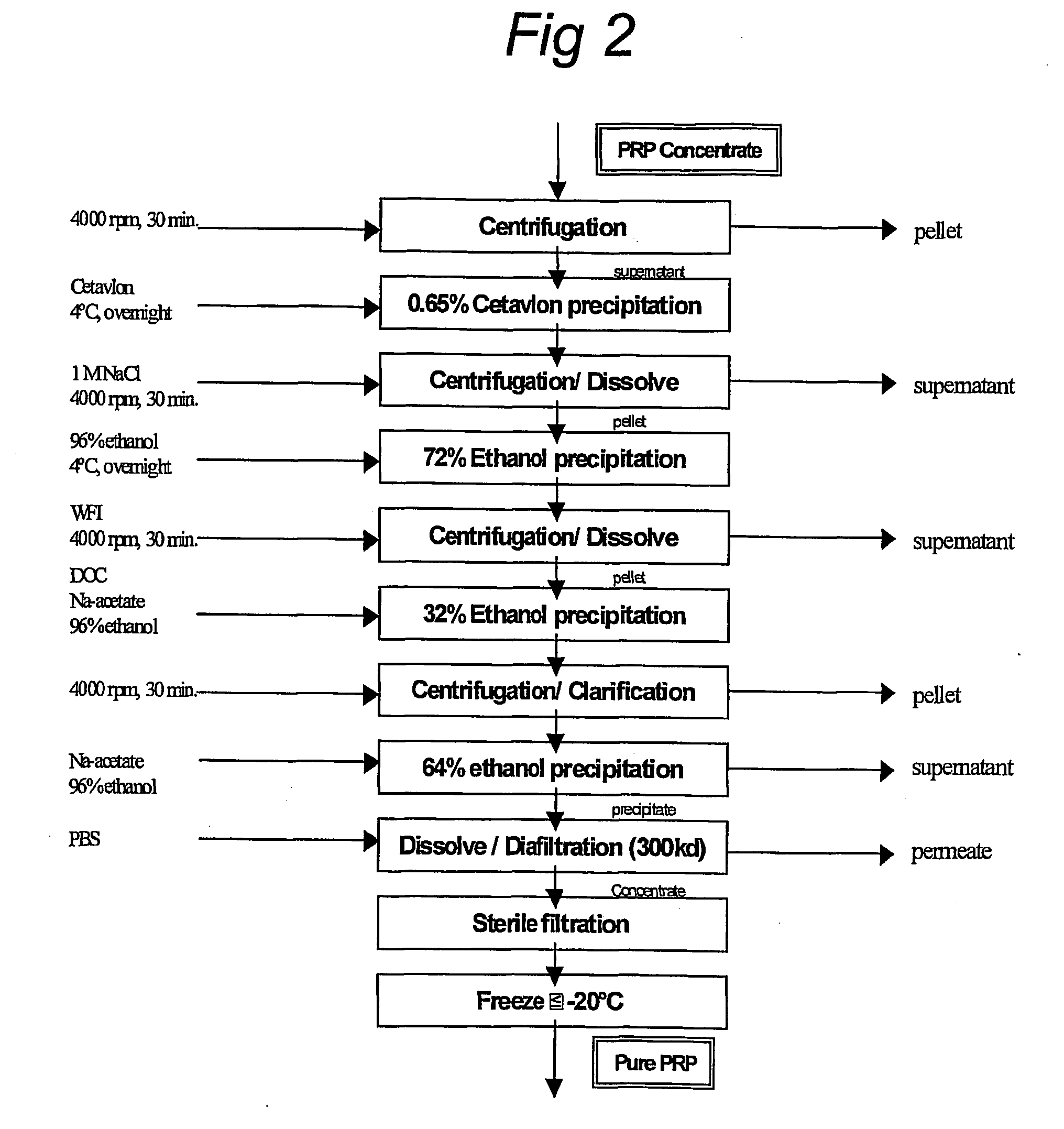Process for producing a capsular polysaccharide for use in conjugate vaccines
a technology of capsular polysaccharide and conjugate vaccine, which is applied in the direction of carrier-bound antigen/hapten ingredients, bacterial antigen ingredients, non-active ingredients of pharmaceuticals, etc., can solve the problem that polysaccharide vaccines appear not to protect infants, hib vaccine is one of the most under-utilized vaccines, and long-term t-cell memory
- Summary
- Abstract
- Description
- Claims
- Application Information
AI Technical Summary
Benefits of technology
Problems solved by technology
Method used
Image
Examples
example 1
Growth test of Haemophilus influenzae type b
[0060] A Haemophilus influeizzae type b strain (A760705) isolated in Amsterdam was cultivated using a 50 1 bioreactor (working volume of 40 1) with a NOVO control system. This strain was identified as being a Haemophilus influenzae type b using commonly used tests, such as immune- and serotyping, and morphology testing. The bioreactor was first filled with the basal medium (compound 1 to 5 in Table 1 dissolved in 35.5 1) before being sterilized in situ for 20 minutes at 110° C. Just before inoculation the proper amount of stock solutions were added to the medium (see Table 2). The bioreactor was inoculated using 11 pre-culture, cultivated on a 3.51 scale using the same medium and a frozen −70° C. seed lot of the Hib strain.
[0061] The pH was kept constant at 7.0 using 5 molVl NaOH. The temperature was kept constant at 35° C. The dissolved oxygen (DO) was kept constant at 30% using air and oxygen through the headspace using a gas flow of 5...
example 2
Production of Polyribosyl Ribitol Phosphate (PRP)
[0067] PRP was produced under the conditions of Example 1 on a 350 1 scale. The cultivation was not continued till all the cells were lyzed but was stopped after 8.3 hours at a pH of 7.43 and an OD590 of 4.4 by starting the cooling using tap water through the bioreactor jacket. The culture was harvested 1.5 hours later using a continuous centrifuge. At the start of the harvest the PRP concentration in the supernatant was equal to 277-377 mg / l, and the temperature of the culture was equal to 19° C. The supernatant was inactivated by adding a 2.7 mol / l formaldehyde solution to the supernatant till a concentration of about 0.1% (v / v). The supernatant was concentrated to about 9.6 1 and diafiltrated using PBS. The concentrated supernatant was stored at ≦−20° C.
example 3
Purification of Polyribosyl Ribitol Phosphate (PRP)
[0068] 1.5 1 concentrated supernatant from Example 2 was purified using the process in FIG. 2 four months after the cultivation.
[0069] After purification, 12 flasks containing each 30 ml liquid pure PRP were freeze-dried to determine the purity based on dry mass (WHO TRS 814 Annex 1 1991 and TRS 897 Annex 1, 2000).
[0070] All the samples (liquid and freeze-dried, including IPC samples) were analyzed for PRP, nucleic acids and protein content. Purified PRP was also analyzed using HP-GPC (Hennessey et al (1993) J. Liq. Chromatogr. 16(8): 1715-1729), NMR (Lernercinier et al (2000) Biologicals 28(3): 175-183), and UV spectroscopy. Determination of ribose (orcinol reaction: Ashwell et al (1957) Meth. Enzyrnol. HI: 73-105), phosphorus (Ames et al (1966) Meth. Enzymol. VIII: 115-118), and residual protein (Lowry et al (1951) J. Biol. Chem. 193: 265-275), was done by colorimetric assays. Endotoxin was measured with the LAL assay.
[0071] S...
PUM
| Property | Measurement | Unit |
|---|---|---|
| pH | aaaaa | aaaaa |
| pH | aaaaa | aaaaa |
| temperature | aaaaa | aaaaa |
Abstract
Description
Claims
Application Information
 Login to View More
Login to View More - R&D
- Intellectual Property
- Life Sciences
- Materials
- Tech Scout
- Unparalleled Data Quality
- Higher Quality Content
- 60% Fewer Hallucinations
Browse by: Latest US Patents, China's latest patents, Technical Efficacy Thesaurus, Application Domain, Technology Topic, Popular Technical Reports.
© 2025 PatSnap. All rights reserved.Legal|Privacy policy|Modern Slavery Act Transparency Statement|Sitemap|About US| Contact US: help@patsnap.com


